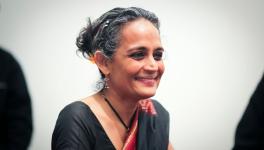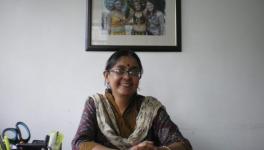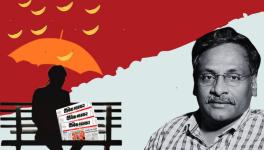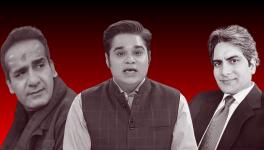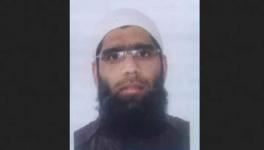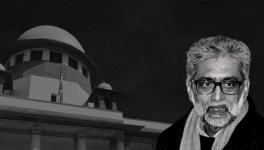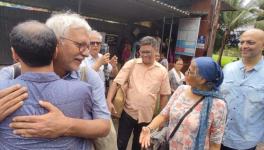Protests Against Stan Swamy’s Arrest Show the Nation the Way
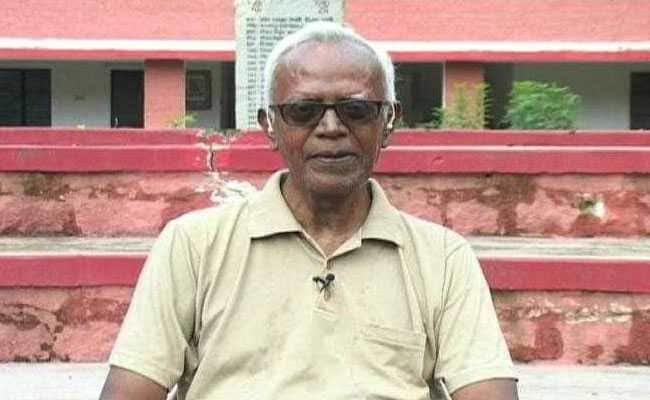
On 9 October, the day after the National Investigation Agency arrested 83-year-old Father Stan Swamy for his alleged role in fomenting violence in Bhima Koregaon in January 2018, a group of 125 activists assembled at Ranchi’s Albert Ekka Chowk. They held placards demanding the release of Swamy. Their spirit soared as Jharkhand Chief Minister Hemant Soren tweeted, on the same morning, against the Bharatiya Janata Party-led Union government. Soren asked, referring to Stan Swamy, “What kind of stubbornness is this to suppress every protesting voice raised against you [BJP]?”
As far as numbers go, a protest by 125 people rarely catches the media’s attention. Since then, though, the protests have only grown. On 12 October, different civil rights groups observed a one-day fast at Birsa Munda Samadhi, Ranchi. At the same site, over the next four days, people assembled between 2 pm and 5 pm, chanting slogans and singing songs. On 16 October, the Catholic Church of Ranchi Diocese organised a human chain, on a 2.5 km-stretch, for an hour, followed by a short prayer in St Mary’s Cathedral for Swamy. On 17 October, all political parties, barring the BJP, participated in Nyay or Justice March, demanding his release.
“Such protests are happening at every place in Jharkhand—Bokaro, Jamshedpur, East and West Singhbhum, Gonda, Giridih,” said social activist Dayamani Barla, breathlessly reeling out names of districts. “We have not had a heavier turnout because people fear stepping out in crowded places and contracting Covid-19.” Economist Jean Dreze provided another reason: “People fear there could be consequences for protesting against the central government.”
Why protests are continuing in Jharkhand
The continuing protests in Jharkhand for the release of Swamy marks a break from the past. From the summer of 2018 until the arrest of Swamy on 8 October, 15 activists had been incarcerated for their alleged role in the Bhima Koregaon violence. Most of them are accomplished academicians and have been appreciated for their work among the underprivileged. Yet their arrests barely triggered sustained protests.
It is possible that Jharkhand has witnessed protests because the government there is not of the BJP. The protestors can hope, especially after Soren fired his volley against the Centre, that the state government will not crack down on peaceful protests. It can also be argued that Swamy, as activists in Jharkhand testify, has an appeal across Jharkhand. For years, he has been educating the Adivasis of their rights and supported them in their fight against the appropriation of their land in the name of development. No less a factor is that he has the support of the Church even though its relationship with him has not always been smooth.
Regardless of all these reasons, Jharkhand’s response to the arrest of Swamy is a moment of some importance in the civil rights movement. Xavier Dias, a Ranchi-based activist, said, “If the protests against the Citizenship Amendment Act moved the nation from Point A to Point B, then the protests against the treatment of Father Stan has moved us to Point C. There is no going back. People have lost the fear of going to jail.”
His proposition will, obviously, get tested in the future. Although the anti-CAA protests were national in their sweep, and intense, yet Delhiites have not let known what they feel about the arrest of young men and women accused of conspiring to foment the communal violence in Delhi in February. This is similar to the charge against the 16 accused in the Bhima Koregaon incident. In both cases, there are many who believe the accused have been falsely framed for sedition and terror activities under the Unlawful Activities (Prevention) Act. However, only the Jharkhandis have publicly expressed their disbelief at the allegation levelled against Swamy.
Not a mass movement
Still, the number of protestors is not substantial enough to unduly worry the central government or the ruling Bharatiya Janata Party, especially as the elections in the state are four years away. Activists say the relatively low level of participation in the protests is not because people are apathetic but because they are poorly informed.
Siraj Dutta, a Ranchi-based social activist, said, “It is media’s role to inform people. They no longer raise issues that could cause discomfort to the Centre. Media coverage of the attacks on civil rights and democratic norms does not reflect the scale of such abuses.” In other words, the blanking out of civil rights violations keeps people in the dark about the Indian state’s leap towards authoritarianism.
“Our media is no longer people’s media,” said Peter Martin, a priest and lawyer in Ranchi. “It manufactures false narratives and creates a distorted version of the reality. So, if someone were to oppose the appropriation of land, the state brands him as a Naxal—and the media echoes the charge.” No wonder, civil rights abuses, of which the poor are victims, fail to prick the collective conscience.
There is also the genuine problem of people’s inability to verify the truth of the state’s narrative against activists. For one, Indians have an implicit faith in the state’s ideological neutrality and honesty. For the other, they feel only the state can crack “conspiracies against the nation.” Their default inclination is to believe the state’s narrative until, obviously, it is punctured by the media or rejected by the judiciary. Trials drag on for years, and the accused languish in jail, forgotten by everyone else other than their families and friends.
It is, therefore, vital that the state is deterred from committing the original sin of implicating people in fake cases and arresting them. But the state will not be deterred unless those who control the levers of power fear they have a price to pay for violating the rights of people. And the only price they do not wish to pay is to lose votes. The other alternative is that the judiciary displays courage to check the state from committing excesses, a feature gradually becoming rarer with time.
Advocacy groups, in most circumstances, lack the wherewithal to mobilise people against the state’s violation of civil rights. With the media tamed and the judiciary failing to provide succour, only political parties can emerge as a counterfoil to the state’s imperious behaviour. “The problem is that almost all political parties are themselves authoritarian,” said Dreze. “I also wonder at the commitment of the middle class to democracy. They could have mounted a more robust resistance to the shrinking of our freedom than they have.”
Yet, quite ironically, it is the Opposition parties, and not the ruling BJP, that fears they would lose votes in case they tried to mobilise people against the violation of civil rights. Few among the Opposition parties opposed the reading down of Article 370, the arrest of Kashmiri leaders and the weeks of lockdown in Kashmir last year.
Xavier Dias explains, “Political parties do not know how to respond when an issue is framed in national security terms.” Thus, Opposition parties did not want to be dubbed as anti-national on the Kashmir issue. They have not intervened in the Bhima Koregaon case because they did not want to be seen as supporting “urban Naxals.” Likewise, with the anti-CAA protestors booked under UAPA, the Opposition parties are wary of being seen as supporting a group accused of conspiring to defame India.
Individual rights versus identity politics
Underlying the Opposition’s diffidence on civil rights lies a socio-political contradiction: rights in the Constitution are granted to the individual. But the unit of political mobilisation in India is either caste or religion or language. Only when the state’s violation of an individual’s rights is also seen as an abrogation of his or her social group’s rights that it acquires a political salience.
For instance, the gang-rape and killing of the Dalit girl in Hathras was framed as a violation of the rights of Dalits, not just of an individual. The possibility of acquiring Dalit support prompted the Opposition parties to take an aggressive posture on the Hathras issue, unmindful of the Uttar Pradesh government’s portrayal that her brutalisation was a fake narrative manufactured by international conspirators to foment caste violence in the state. The death of gangster Vikas Dubey in an encounter became a hot-button issue because he became a symbol of the subordination of Brahmins under the “Rajput rule” of Chief Minister Adityanath.
By contrast, Sudha Bhardwaj or Gautam Navlakha—both accused in the Bhima Koregaon case—have spent years to give a voice to marginalised groups. Their intervention involves mounting pressure on the state to fulfil its constitutional obligations towards citizens. They do not emphasise the Dalit-ness of citizens, but their Indian-ness; they focus upon their class, rather than caste or religious, identity. While a Bhardwaj’s social group will see her politics a threat to its interests, parties espousing the Dalit cause will perceive her caste identity as having little appeal for their supporters.
This connection between civil rights and the politics of identity has led to the tragic loneliness of academician and activist Anand Teltumbde, another accused in the Bhima Koregaon case. He is married to the granddaughter of BR Ambedkar, whom all parties wish to appropriate. Yet even Bahujan Samaj Party leader Mayawati has not forcefully spoken against his targeting. Why?
This is because Teltumbde does not subscribe to the traditional form of Dalit politics. He believes the “core character of caste is like amoeba. It only knows splitting”. In a conversation with this writer in 2018, he explained, “Unless Dalits transcend caste and forge a class unity with other marginalised people, their struggle can never reach a fruition.” This is the primary reason why the Ambedkarites have not expressed their fury over the mistreatment of Teltumbde.
By contrast, Jharkhandis have publically expressed their solidarity with Swamy, a Christian priest. Dayamani Barla explains, “His politics is that of Jal, Jungle and Zameen. He would write articles in newspapers to inform us of our rights. Do you have priests of any religion raising socio-political issues? Father Stan Swamy is far more than [just] Christian to all of us.” Jharkhand may have shown the way to the nation to break the connection between the politics of identity and civil rights.
The author is an independent journalist. The views are personal
Get the latest reports & analysis with people's perspective on Protests, movements & deep analytical videos, discussions of the current affairs in your Telegram app. Subscribe to NewsClick's Telegram channel & get Real-Time updates on stories, as they get published on our website.









